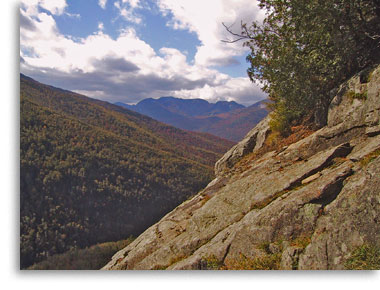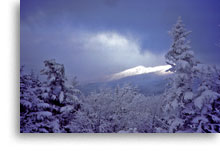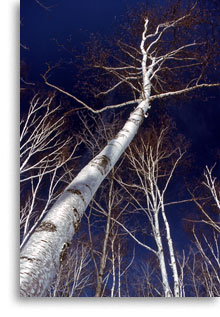
|
|
|
||||||
|
High Peaks Wilderness The High Peaks is home to the highest mountain in New York, Mt. Marcy (5,344 feet). In total 46 Adirondack peaks are above 4000 feet, and as evidenced by a popular hiking club of the same name (the 46-ers), these peaks are frequently the ones “bagged” by summit-seeking hikers. The relatively low elevation of the mountains means few of the summits are above tree-line. The views from cliffs and summits are of forested valleys and mountainsides. Most of the year the evergreen and hardwood trees, relishing the abundant rainfall, create a tapestry of various shades of green. In the autumn, however, the maples, birches, beech and aspen trees produce an extravaganza of red, yellow, orange and rust colors unique to the northeast. Winter blankets the region in snow and ice, frosting the treetops and icing the open rock faces. Vertical rock cliff faces and open swathes of bare rock adorn the mountainsides. Much of the rock is anorthosite, a granitic rock that formed more than 1 billion years ago. This rock layer covers the Adirondack Park and areas northwards into the Canadian Laurentian Mountain region. Since that time erosion, glacial action, and uplifting have exposed the surfaces upon which we climb and ski. During times of heavy rain in the High Peaks, layers of water-saturated soils slide off the underlying rock domes. These newly-exposed areas look like ski runs on the mountainsides, and are nature’s gift to backcountry skiers and scramblers offering open, unforested routes to the summits. After a few years, vegetation creeps back onto the slide areas, and outdoor enthusiasts await the next big slide to open up new areas for exploration. |
||||||
|
Vast Climbing & Skiing Resources Climbers and skiers take advantage of established trails, but also divert off-trail to specific areas of interest. Climbing areas close to roads are plentiful, with short (20 minutes or less) hikes from the car to the start of the climb. These areas are the ones we frequent most because ease of access means more time on the rock or ice. Skiing can be right out the back door, depending on the conditions, but frequently, fresh and reliable snow is just a quick drive away. Remote resources require more commitment in terms of time and preparation. A longer hike, or perhaps an overnight stay, opens the door to climbs and skis best suited for experienced alpinists. These various mountain resources allow us to choose not only routes, but also which type of terrain we wish to climb or ski. We regularly rock and ice climb on about forty major roadside cliffs, and more than twice that number of minor and remote cliffs. Skiing options are just as varied. The many available options allow us to precisely fit an individual’s needs and desires to a particular climb or ski. More detailed information about climbing and skiing routes can be found on the Guiding page for each of our activities, within the Our Services section. |
|
||||||
|
~ Mountain Adventures In the Adirondacks Since 1985 ~ |
|||
|
Alpine Adventures, Inc. |
(518) 576-9881 |
||




